Sometime ago I woke up, had my breakfast, and thought: “I must go on a Baklava tour.” What did that mean? I didn’t really know it myself. But, motivated by bringing nice middle-eastern treats to my family, I was determined to find the best one. Then I realized that sticky pastry might not be the most travel-friendly souvenir. Nonetheless, the idea kept haunting my dreams so my only choice was to do it.
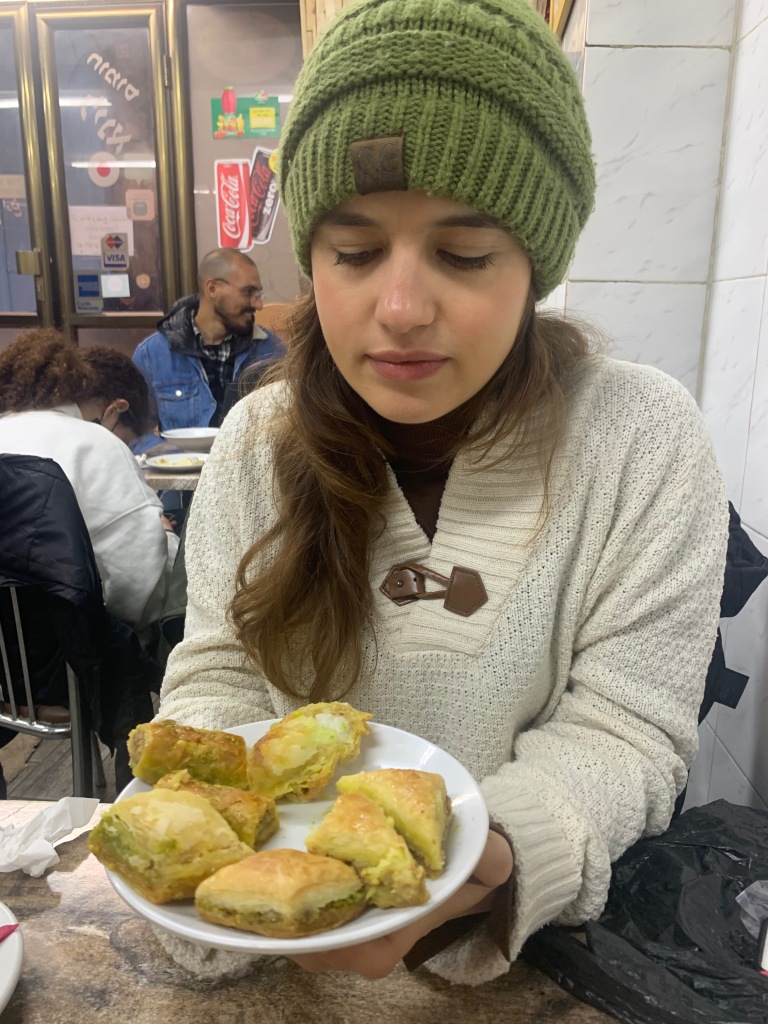
Ok, what is Baklava? This cool guy from theculturemap.com describes it literally yet perfectly: “baklava is a layered pastry sweetened with honey or syrup and filled with nuts. It ends up crispy but dense, sweet but not overly cloying, bready but not entirely.” You might scream, “It isn’t Middle-Eastern, it is Greek!”, or “it’s Turkish!” or “it’s Brazilian! (wrong)”, but relax, it is actually a 2,800 year old recipe hailing from the Assyrian empire: unleavened flat bread with chopped nuts in between, drenched in honey and baked in wood-burning ovens. Who would have thought? The Assyrians were patrons of beer, exile, and baklava. However, the dessert was only disseminated 2,000 years later by the Ottomans (don’t ask me how they got the recipe from the Assyrians…)
Baklava was initially made in the royal kitchens of Constantinople to please very refined and wealthy taste buds. Nowadays you can pay 2 shekels for this piece of heaven. As the Ottomans conquered the Balkans, the Middle East and beyond, they at least had the decency of sharing their culinary delicacies with their conquered subjects. Nowadays different countries perpetuate the different twists their ancestors gave to the Ottoman high-end pastry – with Phyllo dough (Greek), cinnamon and cloves (Armenian), rose-water and orange blossom water (Arabic), diamond shape (Persian)… If you want to know more about the different types, there’s a neat list at the end of the post.
Since I live in the Old City of Jerusalem, where countless shops offer all sorts of things to tourists and locals daily, I decided to make this my target area. I recruited my friend Catherine to be a fellow culinary critic in this endeavour. Although tastes differ, we were in fair agreement about the following ranking:
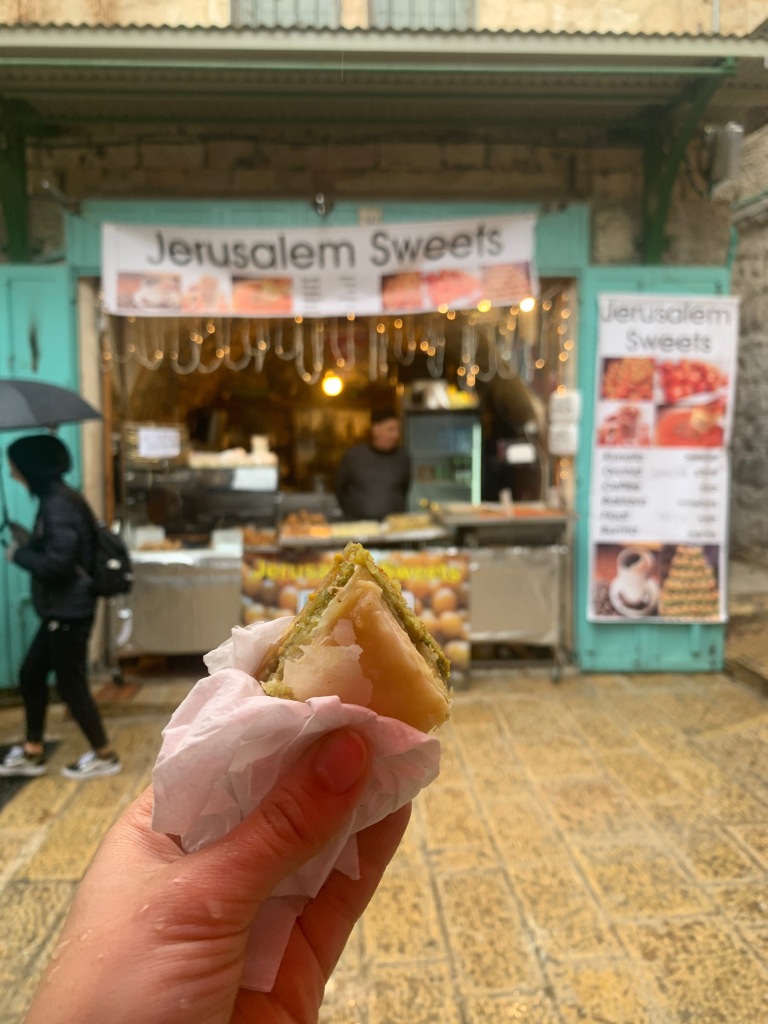

#6 – Jerusalem Sweets (Shuk HaBasamim/Bab El Silsilfh Road)
I pick this one as the least liked simply because it was so expensive compared to the other ones (7₪ a piece!). The seller was friendly (as the smile shows), but his kind smile did not make a mediocre pastry taste much better. Definitely a winner for those who love pistachios, as the pistachio layer was very thick. But the savory punch of the pistachio drowned the sweetness of the syrup, which was very scant. Plus, the pastry itself was very pale. A good option for those who don’t have a sweet tooth, but honestly, you have to embrace the sticky sweetness that soaks the baklava if you’re going for it. Bottom line: expensive and underwhelming.
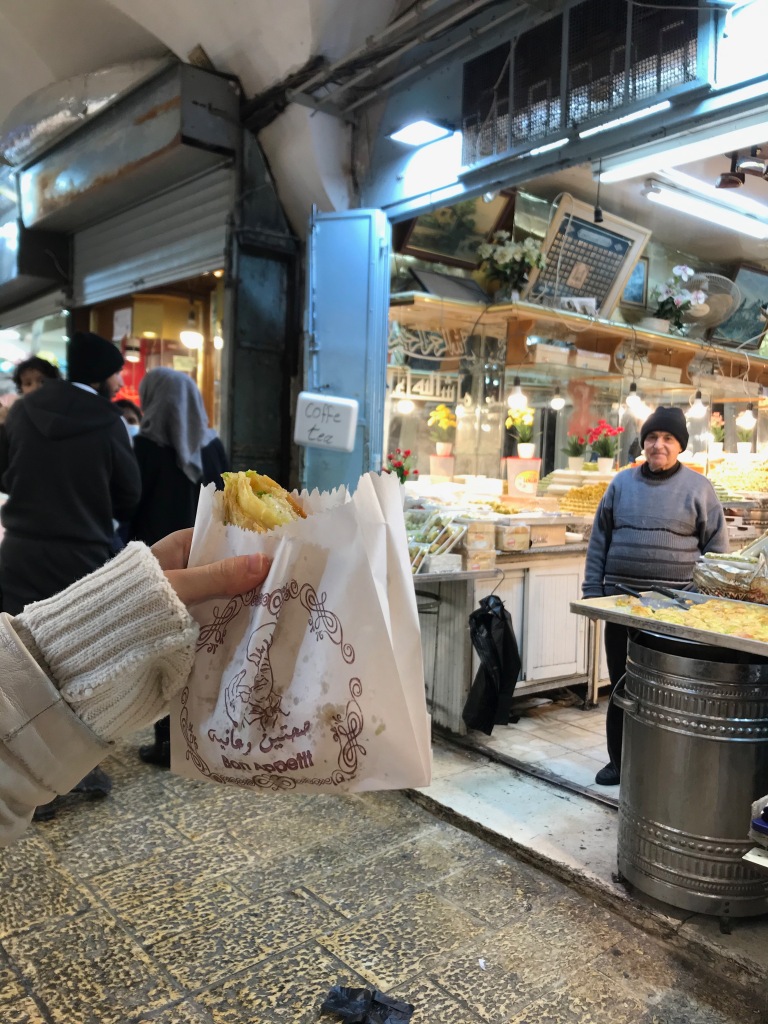
#5 – The nameless store with the generous shopkeeper* (Shuk HaBasamim/ Cardo Street)
Here we got a very big baklava for 5₪. It was a little different because it had cheese in the middle and not a lot of nuts, except some pistachios on top. The dough was alright but the cheese was overwhelming. However, the place does get some points because this nice man slipped an extra piece in the bag for free (I literally did not see him slip in the extra one).

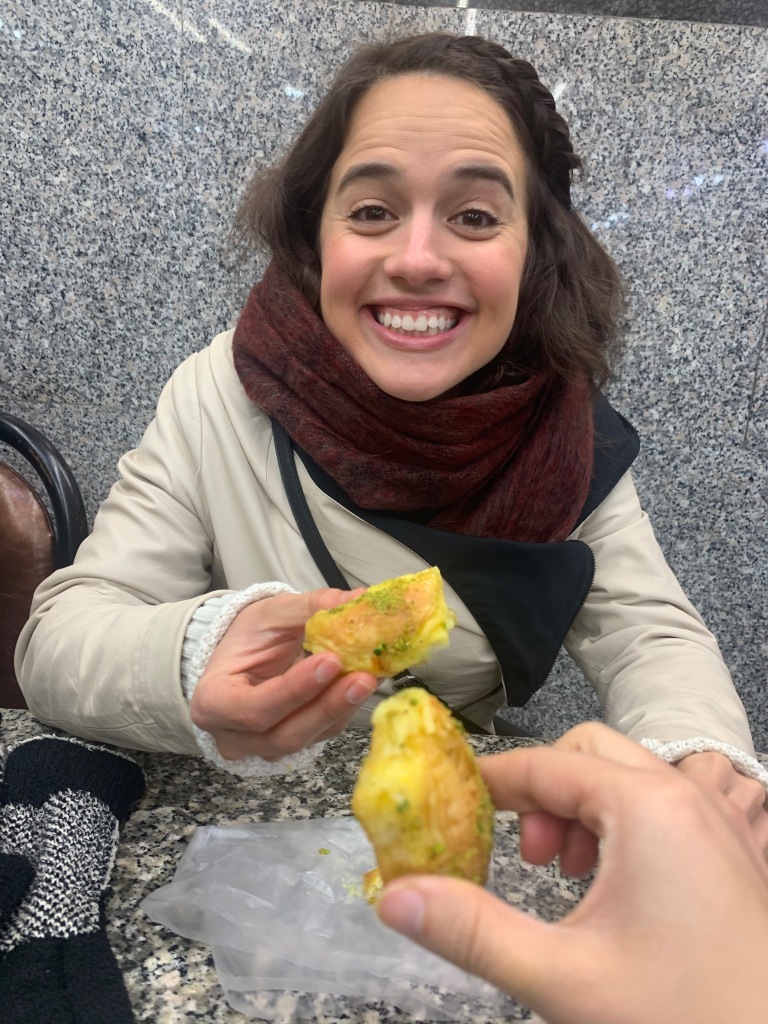
#4 – Jafar Sweets* (Beit HaBad Street)
Jafar Sweets is super well-known for its Knafeh, having been featured in many different TV shows and articles as “the best Knafeh in Jerusalem,” or even Israel. Needless to say, seasoned travellers always take such recommendations with a grain of salt. Although the Knafeh there is pretty good, I can think of a handful of other places that I prefer. I was opened to be proved wrong with their baklava, but although it was tasty, I wouldn’t say it’s the best one in the Old City, let alone Jerusalem. This one was also cheese-filled and perhaps it would be better if eaten warm. No true complaints about it but no real compliments either. If you’d like to drown yourself in more syrup after your Knafeh, why not add this 4₪ delicacy on the side?

#3 – Abu Aziz Eastern Sweets (Via Dolorosa Street/ Al-Wad Street)
We encountered yet another friendly seller and a good sized baklava for a very decent price (4₪ per square!) The pastry was not sickeningly sweet. The walnut layer was good but mild, which in my opinion was because of the thick layer of semolina sitting right above it, taking away some of the pastry’s magic.
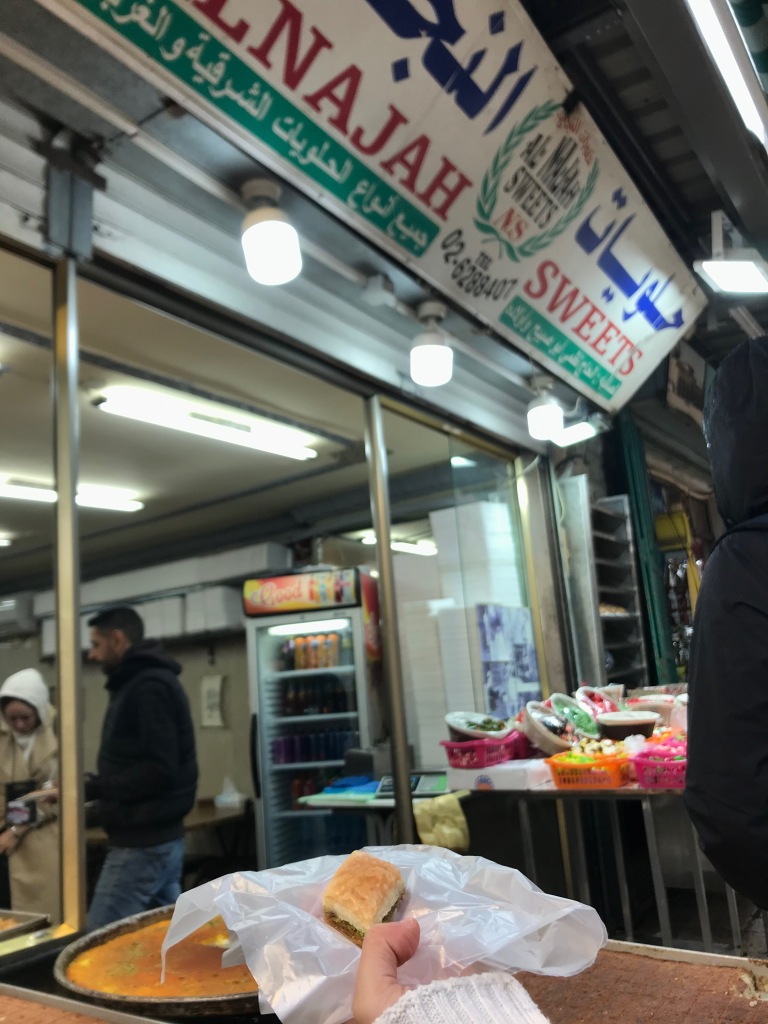
#2 – Alnajah Sweets (Via Dolorosa Street/ Al-Wad Street)
Would you believe I almost thought this shop didn’t sell baklava? The tray was hidden under something else and thankfully I spotted it before giving up. This baklava was cheap (2₪) and delicious, perfect for lovers of crispy pastry. You could still taste the syrup, but it was craftily infused in the walnut filling rather than in the whole pastry. Very light and flaky! I could have easily eaten two more of these.
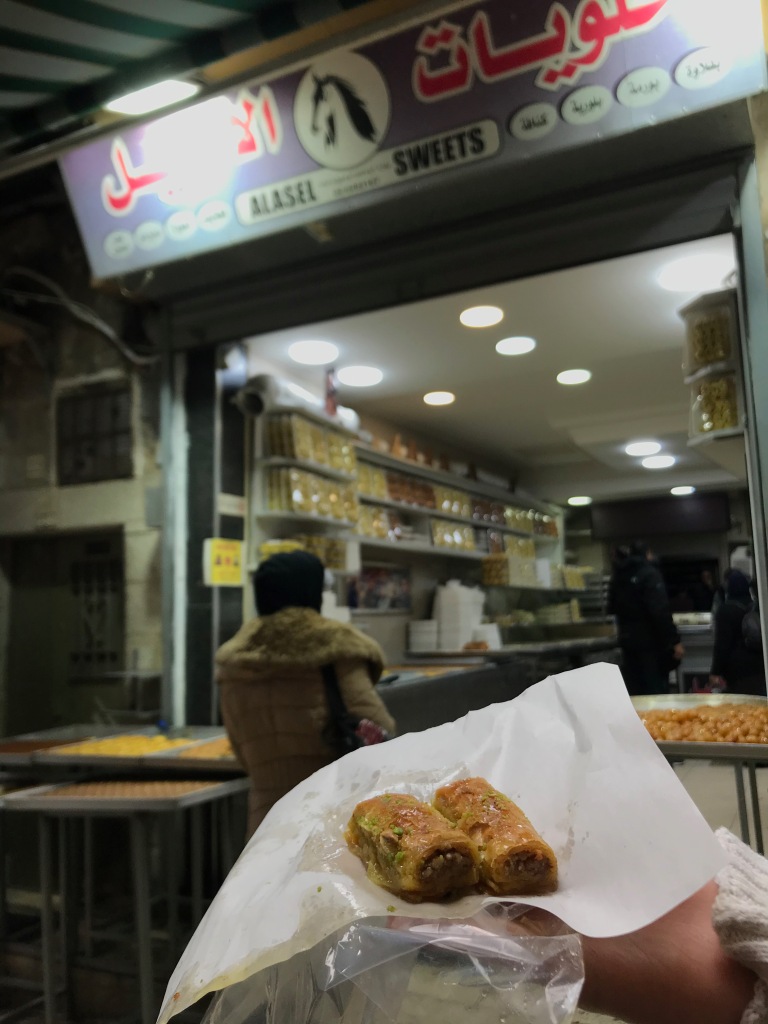
#1 – Alasel Sweets (Via Dolorosa Street/ Al-Wad Street)
The winner was unanimous. The first bite we took was a burst of flavors and the walnut filling was to die for. This one was definitely on the stickier side, but that is the baklava’s charm! If you’re not licking your fingers after you’re done eating, your experience was not complete. Catherine also bought some Luqaimat here, which according to her is one of the best she has ever had. All this goodness for only 2₪ a piece. If you want truly flavorful baklava, Alasel Sweets is the place to check out in the Old City.
*I found out that what we ate at #5 and #4 is actually called Warbat or Shaabiyat. It is pretty much baklava but with a cheese or custard filling, making it a little heavier.


Baklava variations:
- Afghanistan and Cyprus, baklava is prepared into triangle-shaped pieces and is lightly covered in crushed pistachio nuts.
- In Armenia, baklava is made with cinnamon and cloves.
- In Azerbaijan, baklava is mostly prepared during the Nowruz festivity. After preparation the bakhlava is cut into diamond shapes and each piece is garnished with an almond or a walnut.
- In Albania, baklava is a very popular dessert. The dough may include egg yolks, and the filling uses walnuts.
- In the Balkans, it is one of the most popular desserts; though, it is also a dessert made on special occasions (by Muslims, mostly during the holy month of Ramadan and Eid El-Fitr) and by Christians during Easter and Christmas.
- In Bulgaria, baklava is a very popular dessert as well. It is usually made with walnuts and honey syrup, but pistachio is also available.
- In Greece, baklava is supposed to be made with 33 dough layers, referring to the years of Christ’s life.
- In Iran, a drier version of baklava is cooked and presented in smaller diamond-shaped cuts flavored with rose water. The cities of Yazd and Qazvin are famous for their baklava, which is widely distributed in Iran. Persian baklava uses a combination of chopped almonds and pistachios spiced with cardamom and a rose water-scented syrup and is lighter than Middle Eastern versions.
- In Israel, baklava is made of phyllo pastry sheets, nuts, such as pistachios, walnuts, hazelnuts, and almonds, sweet butter, clove, sugar, cinnammon, and the syrup combined with orange and lemon rind.
- In Jordan, baklava is made of dough layers filled with nuts, such as pistachios, and sugar or honey syrup.
- In Lebanon, baklava is made of phyllo dough sheets filled with nuts (pistachios, walnut, cashews, pine nuts, almonds) and steeped in “Atir” syrup made of orange blossom water and rose water, sugar and water. It is cut into a variety of triangular rectangular, diamond or square shapes. The city of Tripoli in Lebanon is famous for its baklava products.
- In Syria, baklava is prepared from phyllo dough sheets, butter, walnuts and sugar syrup. It is cut into lozenge pieces. Baklava from Aleppo is made with the local pistachios and “samna” from Hama.
- In Turkey, baklava is traditionally made by filling in-between the layers of dough with pistachios, walnuts, almonds (parts of the Aegean Region) or a special preparation called “kaymak”. In the Black Sea Region hazelnuts are commonly used as a filling for baklava. The city of Gaziantep in southeast Turkey is famous for its pistachio baklava and regarded there as its native city, though it only appears to have been introduced to Gaziantep from Damascus in 1871. In 2008, the Turkish patent office registered a geographical indication for Antep Baklava. In many parts of Turkey, baklava is often topped with kaymak or, in the summer, ice cream (milk cream flavour, called “kaymaklı dondurma”).
Source: https://libanaissweets.com/about-us/the-history-of-baklava/